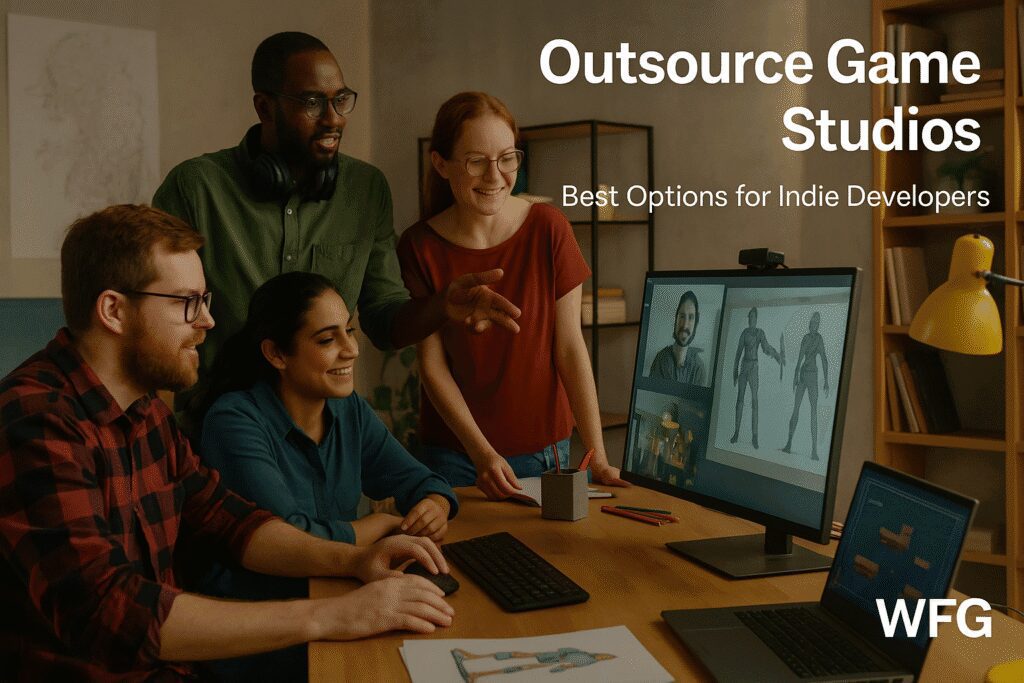Indie game development has always been a playground for creativity, but it comes with tough challenges: small teams, limited budgets, and tight deadlines. That’s why many indie developers are increasingly turning to outsource game studios. Outsourcing provides affordable access to specialized skills like art, coding, and quality testing without the overhead of building a large in-house team. In this guide, we’ll explore why outsourcing makes sense for indie developers, the services studios offer, and most importantly, which outsource game studios are the best options for indie creators in 2025.

Why Indie Developers Outsource Game Studios
- Budget-Friendly Production – Hiring a full in-house team is often impossible for indie studios. Outsourcing allows access to expert talent at flexible pricing.
- Specialized Expertise – From 3D modeling to sound design, outsource game studios give indies access to skills they might not have internally.
- Faster Development Cycles – Outsourcing enables indie teams to speed up production without burning out.
- Scalability – Developers can outsource specific stages (art, coding, QA) instead of committing to long-term hires.
Key Services Outsource Game Studios Provide
- Game Art & Animation – Concept art, character design, 2D/3D modeling, rigging, and animations.
- Programming & Development Support – Coding support, engine expertise (Unity, Unreal), and feature implementation.
- Sound Design & Music – Original scores, sound effects, and voiceover integration.
- Quality Assurance (QA) & Testing – Playtesting, bug tracking, and performance optimization.
- Full-Cycle Development – End-to-end services from concept to release.
How to Choose the Right Outsource Game Studio
- Portfolio Review – Look for past projects in your genre or similar art style.
- Communication & Time Zones – Seamless collaboration often depends on overlapping work hours.
- Pricing Models – Compare hourly vs. project-based contracts.
- Reputation & Reviews – Seek out testimonials and feedback from other indie developers.
Best Outsource Game Studios for Indie Developers in 2025
Here are some reliable outsourcing studios that indie developers can confidently explore:
Read also: Slot Machines Strategy.
1. Keywords Studios
- Global leader with expertise in art, localization, audio, and QA.
- Known for working with both AAA and indie studios.
- Great for teams needing multi-service outsourcing.
2. Virtuos
- Offers art, co-development, and porting services.
- Strong reputation for high-quality 3D art and environments.
- Ideal for indies seeking AAA-level visual quality.
3. Room 8 Studio
- Specializes in 2D/3D art, game development, and trailers.
- Works closely with indie studios for tailored support.
- Recommended for visual storytelling and marketing assets.
4. Tose
- Japanese studio with decades of outsourcing experience.
- Known for behind-the-scenes contributions to major franchises.
- Best for indies needing reliable long-term support.
5. Lakshya Digital
- Focused on art outsourcing with studios across India, Japan, and the US.
- Affordable without compromising quality.
- Great choice for budget-conscious indie developers.
Cost of Hiring Outsource Game Studios for Indie Projects
- Art & Animation – $25–$60/hour depending on complexity.
- Programming Support – $30–$80/hour for Unity/Unreal specialists.
- Sound Design – $500–$2,000 per project, depending on scope.
- Full-Cycle Development – $20,000–$100,000+ depending on project scale.
Pro Tip: Start with smaller test contracts to evaluate quality before committing to larger projects.
Mistakes Indie Developers Should Avoid When Outsourcing
- Choosing the cheapest option only – Low cost can lead to poor quality.
- Unclear expectations – Always define scope, deadlines, and deliverables upfront.
- Lack of communication – Misalignment often causes delays.
- Overloading scope – Outsource in stages instead of overwhelming the studio with full-scale tasks at once.
Final Thoughts: Finding the Right Partner for Your Indie Game
Can You Win Real Money on Free Slots The truth Reviewed.
Outsourcing is no longer just a strategy for big studios — indie developers are embracing it as a way to compete in today’s fast-paced gaming industry. The key is to choose an outsource game studio that understands indie constraints: budget, flexibility, and creativity. With the right partner, indie devs can transform ambitious ideas into polished, market-ready games.
FAQ Section
What does an outsource game studio do?
They provide specialized services like art, programming, audio, or QA support for game development.
Is outsourcing cheaper than hiring freelancers?
Outsourcing studios often provide better consistency and scalability compared to individual freelancers, though freelancers may be cheaper for very small tasks.
How do indie game developers find reliable outsource studios?
By reviewing portfolios, checking testimonials, and starting with small trial projects.
Can outsourcing handle a full game project or just parts?
Many studios offer both full-cycle development and partial support depending on client needs.



